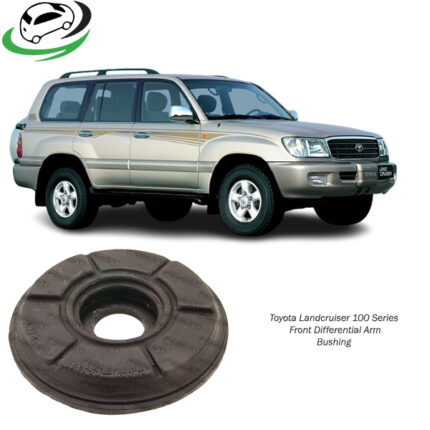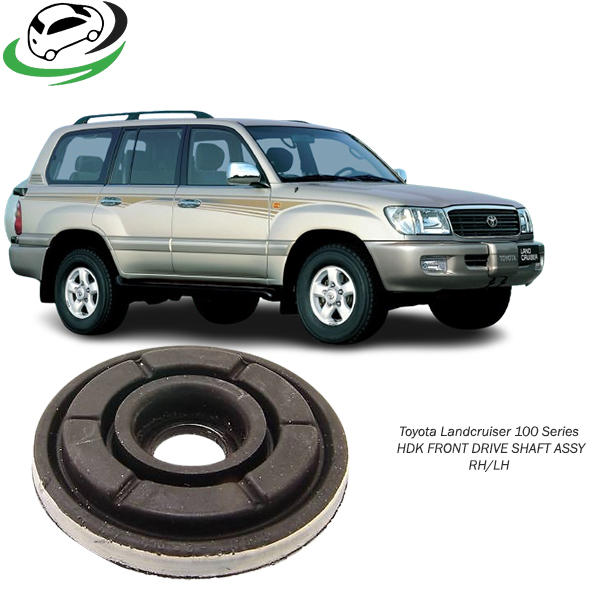-20%
Get Toyota Landcruiser 100 Series Front Arm Bushing RH TAB-334 in Kenya
The differential arm bushing is a crucial component in a vehicle’s suspension system, primarily contributing to the vehicle’s handling, stability, and overall ride comfort. It serves as a mount for the differential and plays a pivotal role in isolating the differential from the rest of the vehicle, thereby reducing noise, vibration, and harshness (NVH). Understanding the function, types, materials, and common issues related to differential arm bushings can provide insights into their importance in automotive engineering.
Function of Differential Arm Bushing;
1. Vibration Damping
The differential arm bushing isolates the differential from the vehicle’s chassis, minimizing the transmission of vibrations and noise to the passenger cabin. This helps in providing a smoother and quieter ride by reducing the noise, vibration, and harshness (NVH) levels.
2. Alignment Maintenance
The bushing ensures that the differential remains properly aligned with the drive axles. This alignment is critical for efficient power transmission from the engine to the wheels. Proper alignment also helps in maintaining consistent handling and stability of the vehicle.
3. Shock Absorption
During driving, the vehicle encounters various road conditions that produce shocks and impacts. The differential arm bushing absorbs these shocks, protecting the differential and other drivetrain components from damage. This absorption also prevents the transfer of harsh impacts to the chassis, contributing to overall vehicle comfort.
4. Flexibility and Movement
The bushing allows for a controlled amount of movement and flexibility of the differential relative to the chassis. This flexibility is essential for accommodating the dynamic loads and stresses that occur during acceleration, braking, and cornering. It ensures that the differential can move slightly without causing misalignment or damage to other components.
5. Load Distribution
The differential arm bushing helps in distributing the loads and stresses experienced by the differential evenly across the suspension system. This distribution prevents excessive wear and tear on any single component, enhancing the longevity and reliability of the drivetrain.
6. Reducing Metal-to-Metal Contact
By providing a cushion between the differential and the chassis, the bushing reduces metal-to-metal contact. This reduction minimizes wear and tear on the metal components, lowering the risk of damage and extending the lifespan of both the differential and the chassis.
Types of Differential Arm Bushings
Differential arm bushings come in various designs, each suited for different vehicle requirements and driving conditions. The main types are:
- Rubber Bushings: The most common type, made from natural or synthetic rubber. They offer excellent vibration damping and are cost-effective. However, they can wear out relatively quickly, especially under harsh driving conditions.
- Polyurethane Bushings: These bushings are more durable and resistant to wear and chemicals compared to rubber bushings. They provide better performance and longevity but can be harsher, transmitting more noise and vibration.
- Solid Bushings: Made from metal or hard plastic, these bushings are used in high-performance or racing applications where maximum rigidity and alignment precision are required. They offer the least vibration damping and can significantly increase NVH.
- Hydraulic Bushings: Incorporating a hydraulic fluid chamber, these bushings provide superior damping characteristics. They are commonly used in luxury and high-end vehicles to ensure a smooth and quiet ride.
Materials Used in Differential Arm Bushings
The materials used in the construction of differential arm bushings directly affect their performance, durability, and cost.
- Rubber: Natural rubber is valued for its excellent flexibility and vibration damping properties. Synthetic rubbers, such as neoprene and EPDM, offer enhanced resistance to heat, oil, and ozone.
- Polyurethane: Known for its toughness, polyurethane provides better resistance to abrasion, chemicals, and aging. It is ideal for high-stress applications.
- Metal: Metals like steel or aluminum are used in solid bushings for their rigidity and durability. These are typically found in performance-oriented vehicles.
- Composite Materials: Advanced composites can offer a balance between flexibility and strength, often used in modern, high-performance bushings.
Signs of a worn out differential Bushing;
1. Unusual Noises
- Clunking or Thumping Sounds: When accelerating, decelerating, or shifting gears, you might hear clunking or thumping noises coming from the rear of the vehicle. This is often due to excessive play in the differential caused by a degraded bushing.
- Squeaking or Creaking Sounds: Worn bushings can cause squeaking or creaking noises, especially when going over bumps or during cornering.
2. Poor Handling and Stability
- Wandering or Loose Feeling: The vehicle may feel less stable, with a tendency to wander or feel loose, especially at higher speeds. This can be due to the differential moving excessively because of a worn bushing.
- Increased Body Roll: During cornering, you might notice increased body roll or swaying, indicating that the differential is not properly aligned due to a failing bushing.
3. Vibration and Harshness
- Increased Vibrations: A worn bushing can no longer effectively isolate the differential from the chassis, leading to increased vibrations felt in the cabin, particularly at higher speeds or during acceleration.
- Harsh Ride: The overall ride quality may become harsher, with more road imperfections and shocks being felt due to the reduced cushioning effect of the worn bushing.
4. Differential Misalignment
- Uneven Tire Wear: Misalignment caused by a failing bushing can result in uneven tire wear, particularly on the rear tires. This can also lead to reduced tire lifespan and the need for more frequent replacements.
- Drivetrain Issues: Misalignment can cause additional strain on the drivetrain components, potentially leading to issues such as increased wear on the driveshaft, axles, and other related parts.
5. Leaking Differential Fluid
- Fluid Leaks: A damaged bushing may cause the differential housing to shift or move excessively, leading to potential leaks of differential fluid. This can be observed as wet spots or puddles under the vehicle.
6. Visual Inspection
- Visible Damage: During a visual inspection, you might notice cracks, tears, or other visible signs of wear and deterioration on the bushing. The bushing may appear compressed, misshapen, or otherwise degraded.
Maintenance and Replacement
Regular inspection and maintenance of differential arm bushings are vital for vehicle performance and safety. Signs that bushings may need replacement include unusual noises, poor handling, and visible cracks or wear.
Replacement Process:
- Vehicle Preparation: Ensure the vehicle is safely lifted and supported.
- Remove the Differential Arm: Depending on the vehicle, this may involve disconnecting various suspension and drivetrain components.
- Remove the Old Bushing: This often requires special tools to press out the old bushing.
- Install the New Bushing: Press the new bushing into place, ensuring it is correctly aligned.
- Reassemble the Differential Arm: Reattach all components and ensure everything is torqued to the manufacturer’s specifications.
Follow us on Facebook for more parts.



